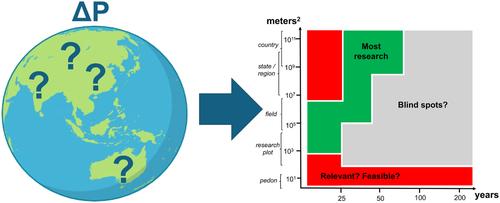当前位置:
X-MOL 学术
›
Glob. Change Biol.
›
论文详情
Our official English website, www.x-mol.net, welcomes your feedback! (Note: you will need to create a separate account there.)
Missing phosphorus legacy of the Anthropocene: Quantifying residual phosphorus in the biosphere
Global Change Biology ( IF 10.8 ) Pub Date : 2024-06-26 , DOI: 10.1111/gcb.17376 Andrew J. Margenot 1 , Shengnan Zhou 1 , Suwei Xu 1 , Leo M. Condron 2 , Geneviève S. Metson 3 , Philip M. Haygarth 4 , Jordon Wade 5 , Prince C. Agyeman 6
Global Change Biology ( IF 10.8 ) Pub Date : 2024-06-26 , DOI: 10.1111/gcb.17376 Andrew J. Margenot 1 , Shengnan Zhou 1 , Suwei Xu 1 , Leo M. Condron 2 , Geneviève S. Metson 3 , Philip M. Haygarth 4 , Jordon Wade 5 , Prince C. Agyeman 6
Affiliation

|
A defining feature of the Anthropocene is the distortion of the biosphere phosphorus (P) cycle. A relatively sudden acceleration of input fluxes without a concomitant increase in output fluxes has led to net accumulation of P in the terrestrial‐aquatic continuum. Over the past century, P has been mined from geological deposits to produce crop fertilizers. When P inputs are not fully removed with harvest of crop biomass, the remaining P accumulates in soils. This residual P is a uniquely anthropogenic pool of P, and its management is critical for agronomic and environmental sustainability. Managing residual P first requires its quantification—but measuring residual P is challenging. In this review, we synthesize approaches to quantifying residual P, with emphasis on advantages, disadvantages, and complementarity. Common approaches to estimate residual P are mass balances, long‐term experiments, soil test P trends and chronosequences, with varying suitability or even limitations to distinct spatiotemporal scales. We demonstrate that individual quantification approaches are (i) constrained, (ii) often complementary, and (iii) may be feasible at only certain time–space scales. While some of these challenges are inherent to the quantification approach, in many cases there are surmountable challenges that can be addressed by unifying existing P pool and flux datasets, standardizing and synchronizing data collection on pools and fluxes, and quantifying uncertainty. Though defined as a magnitude, the distribution and speciation of residual P is relatively less understood but shapes its utilization and environmental impacts. The form of residual P will vary by agroecosystem context due to edaphoclimatic‐specific transformation of the accumulated P, which has implications for management (e.g., crop usage) and future policies (e.g., lag times in P loading from non‐point sources). Quantifying the uncertainty in measuring residual P holds value beyond scientific understanding, as it supports prioritization of monitoring and management resources and inform policy.
中文翻译:

人类世缺失的磷遗产:量化生物圈中的残留磷
人类世的一个决定性特征是生物圈磷(P)循环的扭曲。输入通量的相对突然加速而输出通量没有随之增加,导致陆地-水生连续体中磷的净积累。在过去的一个世纪里,人们从地质矿藏中开采磷来生产农作物肥料。当作物生物量收获时磷输入未完全去除时,剩余的磷会在土壤中积累。这种残留磷是独特的人为磷库,其管理对于农艺和环境可持续性至关重要。管理残余 P 首先需要对其进行量化,但测量残余 P 具有挑战性。在这篇综述中,我们综合了量化残余 P 的方法,重点是优点、缺点和互补性。估计残留磷的常用方法是质量平衡、长期实验、土壤测试磷趋势和时间序列,对不同的时空尺度具有不同的适用性甚至局限性。我们证明,单独的量化方法是(i)受到限制的,(ii)通常是互补的,以及(iii)仅在某些时空尺度上可行。虽然其中一些挑战是量化方法所固有的,但在许多情况下,存在可以克服的挑战,可以通过统一现有的磷库和通量数据集、标准化和同步池和通量的数据收集以及量化不确定性来解决。虽然残留磷的分布和形态虽然被定义为一个量值,但人们对它的了解相对较少,但却决定了其利用和环境影响。 由于累积磷的土壤气候特定转化,残留磷的形式将因农业生态系统背景而异,这对管理(例如作物使用)和未来政策(例如非点源磷加载的滞后时间)具有影响。量化剩余 P 测量的不确定性具有超出科学理解的价值,因为它支持监测和管理资源的优先顺序并为政策提供信息。
更新日期:2024-06-26
中文翻译:

人类世缺失的磷遗产:量化生物圈中的残留磷
人类世的一个决定性特征是生物圈磷(P)循环的扭曲。输入通量的相对突然加速而输出通量没有随之增加,导致陆地-水生连续体中磷的净积累。在过去的一个世纪里,人们从地质矿藏中开采磷来生产农作物肥料。当作物生物量收获时磷输入未完全去除时,剩余的磷会在土壤中积累。这种残留磷是独特的人为磷库,其管理对于农艺和环境可持续性至关重要。管理残余 P 首先需要对其进行量化,但测量残余 P 具有挑战性。在这篇综述中,我们综合了量化残余 P 的方法,重点是优点、缺点和互补性。估计残留磷的常用方法是质量平衡、长期实验、土壤测试磷趋势和时间序列,对不同的时空尺度具有不同的适用性甚至局限性。我们证明,单独的量化方法是(i)受到限制的,(ii)通常是互补的,以及(iii)仅在某些时空尺度上可行。虽然其中一些挑战是量化方法所固有的,但在许多情况下,存在可以克服的挑战,可以通过统一现有的磷库和通量数据集、标准化和同步池和通量的数据收集以及量化不确定性来解决。虽然残留磷的分布和形态虽然被定义为一个量值,但人们对它的了解相对较少,但却决定了其利用和环境影响。 由于累积磷的土壤气候特定转化,残留磷的形式将因农业生态系统背景而异,这对管理(例如作物使用)和未来政策(例如非点源磷加载的滞后时间)具有影响。量化剩余 P 测量的不确定性具有超出科学理解的价值,因为它支持监测和管理资源的优先顺序并为政策提供信息。











































 京公网安备 11010802027423号
京公网安备 11010802027423号